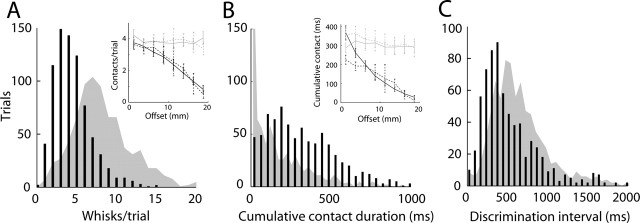Figure 8.
Whisk counts and discrimination speed. A, Distribution of the number of contacting whisks (black bars) and contacting plus noncontacting whisks (gray area) during localization trials. The inset shows the number of whisks that contacted the anterior (black) and posterior (gray) poles during correct (solid lines) or incorrect (dashed lines) trials as a function of horizontal offset. B, The distribution of cumulative contact durations with either the anterior (gray fill; median of 108 ms) or the posterior (black bars; median of 286 ms) pole is shown. The inset shows cumulative contact durations with anterior (black) and posterior (gray) poles as a function of horizontal offset separately for correct (solid lines) and incorrect (dashed lines) trials. C, Distributions of delays between the time of the first whisker–object contact and nose-poke detachment (black bars; median of 406 ms) and of intervals between the first object contact and the last object detach in a trial (gray fill; median of 588 ms). In A–C, data were included from sessions in which rats had a single pair of whiskers intact (ALL–C2, ALL–ARC–C2, ARC–C2, and ROW–C2) and in which the threshold of the session (2.4 ± 0.9 mm) had a chance probability ≤0.05 (9 rats, 18 sessions, 777 trials).

